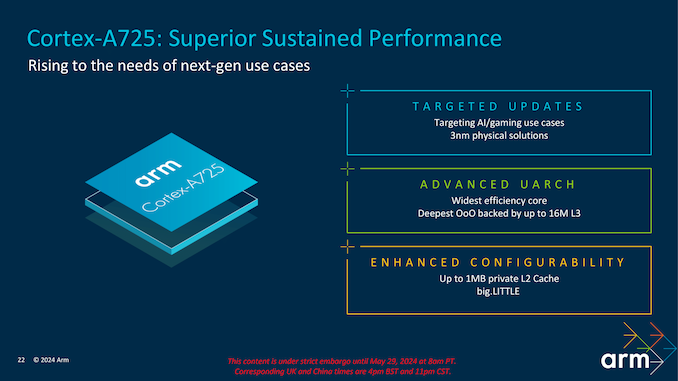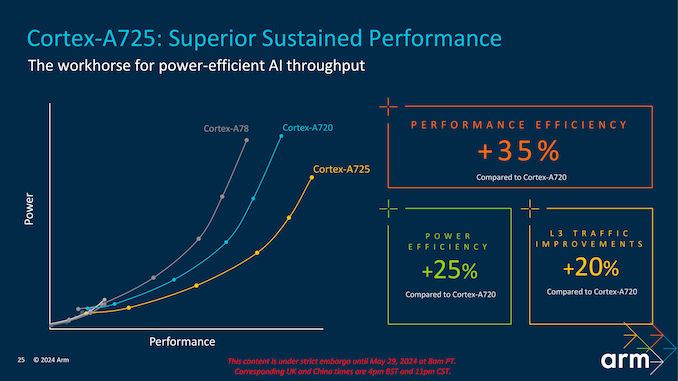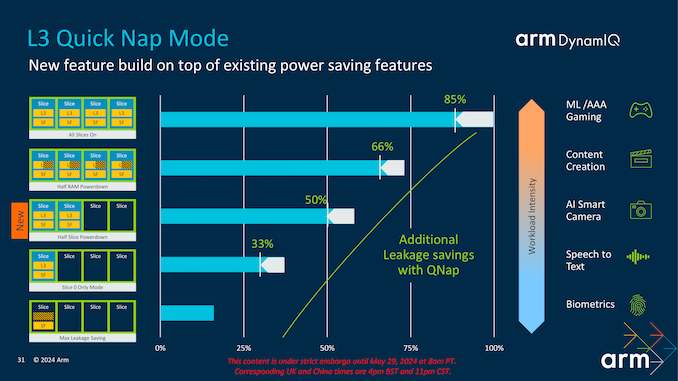Arm Unveils 2024 CPU Core Designs, Cortex X925, A725 and A520: Arm v9.2 Redefined For 3nm
by Gavin Bonshor on May 29, 2024 11:00 AM EST- Posted in
- CPUs
- Arm
- Smartphones
- Mobile
- SoCs
- Cortex
- 3nm
- Armv9.2
- Cortex-A520
- Cortex X925
- Cortex A725
Arm Cortex A725: Improvements to Middle Core Efficiency
The Arm Cortex-A725 is designed to balance performance and power efficiency, making it a critical component of the second-generation Armv9.2 architecture. Positioned as a mid-tier core, it complements the high-performance Cortex-X925 by offering robust capabilities for everyday computing tasks while maintaining energy efficiency. This core is especially targeted at devices that require consistent performance without the high power consumption associated with top-tier cores, such as smartphones, tablets, and laptops.
The Cortex-A725 builds on the successes of its predecessor, the Cortex-A720, with several key architectural enhancements. One of the significant improvements is the increased instruction issue queue and the expanded reorder buffer, which enable the core to handle more instructions simultaneously and execute them out of order for improved efficiency. This increase in the out-of-order execution window size allows the Cortex-A725 to utilize its execution units better, leading to smoother and faster processing of complex workloads.
The core also benefits from a new 1MB L2 cache configuration, which provides faster access to frequently used data and instructions. This larger cache size is designed to reduce latency and improve performance, particularly for applications that require rapid data retrieval. Additionally, the Cortex-A725 features enhancements in its register file structure, further streamlining data processing and reducing bottlenecks.
Power efficiency is a crucial aspect of the Cortex-A725's design. With leading-edge 2024 Cortex chips expected to be fabbed on newly-available 3nm process technologies from TSMC and others, the improved performance from these nodes is able to drive big improvements in energy efficiency, and Arm is leaning into that heavily with the A725. Overall, Arm is touting that A725 delivers significant power savings compared to previous generations. Compared to the Cortex-A720, the Cortex-A725 offers up to a 25% improvement in power efficiency (and 20% L3 traffic reduction), making it an ideal choice for mobile devices that require long battery life.
The core also features advanced power management capabilities, including dynamic voltage and frequency scaling (DVFS) and half-slice power-down modes. These features allow the Cortex-A725 to adjust its power consumption based on the current workload, ensuring energy is used efficiently without sacrificing performance.













55 Comments
View All Comments
ET - Thursday, May 30, 2024 - link
I'm not sure why you're attributing this to insecurity and desperation when it's all about money. I can understand why end users would prefer companies to invest into things they feel are more relevant, but jumping on bandwagons (and driving them forward) is exactly the thing that companies wanting to keep their market healthy should do. ReplyGeoffreyA - Thursday, May 30, 2024 - link
Agreed; it is all about money. Generally, it is not to the benefit of the consumer or the world. An AI PC might be good for Jensen, Pat, Satya, Tim, Lisa, and co. but does not help most people. Replymode_13h - Thursday, May 30, 2024 - link
Ooh, you just got "named!"Seriously, your comment does indeed sound snarky and your reply sounds defensive and even a bit insecure. I don't think name99 was suggesting that you should want to be a genius, but rather pointing out that it pays to think beyond a single track.
> when one see Microsoft and Intel making an "AI PC," or AMD calling their
> CPU "Ryzen AI," and so on, it is little about true AI and more about money,
> checklists, and the bandwagon.
I'm reminded of when 3D-capable GPUs went so mainstream you could scarcely buy a PC without it. Yet, the killer app for the average PC user had yet to be invented. To some extent, the hardware needs to lead the way before mainstream apps can fully exploit the technology, because software companies aren't going to invest the time & effort in making features & functionality that only a tiny number of users can take advantage of.
Also, you say you want AI models to use little power, but progress happens incrementally and having hardware assist indeed improves the efficiency of inferencing on models that aren't all as big or demanding as LLMs. Reply
GeoffreyA - Thursday, May 30, 2024 - link
Fair enough. I apologise to everyone for negative connotations in my comment and replies, but the companies are free game and we ought to poke fun at them. I'm fed up, with the lies, marketing, double standards, doublespeak, and nonsense. These companies are only after money, and we are the fools at the end of the day. The last few years it was cloud; now, it's AI. What's next? ReplyGeoffreyA - Thursday, May 30, 2024 - link
As I've said, both here and in several comments elsewhere, AI and LLMs are of immense interest to me. I believe they're the Stone Age version of the stuff in our brains. What I'm trying to criticise is not LLMs or the technology, but the marketing ripoff that is bombarding us everywhere, this so-called AI PC, Copilot PC, or whatever Apple calls theirs. It's laughable the way they're plastering the term AI all over products. ReplySydneyBlue120d - Thursday, May 30, 2024 - link
Can we expect Samsung S25 3nm Exynos 2500 SOC to be based on this cores? Replyeastcoast_pete - Sunday, June 2, 2024 - link
After their rather poor showing with their Mongoose custom cores, I'd be very surprised if Samsung doesn't stick with ARM's designs for the CPU side of the Exynos 2500. What's (IMHO) really interesting right now is what Samsung will use for their GPU for the 2500. Rumors abound, many saying that they'll walk away from XDNA and use an in-house designed GPU, or come back to the ARM Mali mothership. The latter would put them in an awkward position, as Mediatek is likely the first out of the gate with their new 9400 featuring both the newest ARM cores and whatever the new version of Immortalis will be called. And Mediatek's Dimensity 9400 is (will be?) fabbed on TSMC's newest 3 nm node, so Samsung will want to have maximum differentiation here. ReplyJames5mith - Thursday, May 30, 2024 - link
"The enhanced AI capabilities ensure these applications run efficiently and effectively, delivering faster and more accurate results."ARM hardware will magically fix AI algorithms to be better than they otherwise would be? Really?!? Reply
mode_13h - Thursday, May 30, 2024 - link
They're probably referring to the fact that it can deliver good inferencing performance without having to resort to the sorts of extreme quantization behind some companies TOPS claims. Quantization often comes at the expense of accuracy, especially if it's done after training, rather than the model being designed and trained to utilize some amount of quantized weights. ReplyJames5mith - Thursday, May 30, 2024 - link
Also, amazing increases in performance per watt doesn't mean less power draw. If it draws 3x the power to do 4x the work, then it's increased efficiency 1.33x. But it's still drawing 3x the power. That means a battery will be drained 3x faster.Saying the 30w SoC does work more efficiently than the 10w SoC doesn't make it draw less power. Reply